

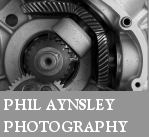
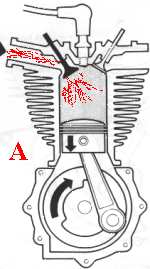
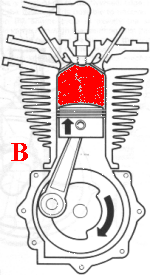
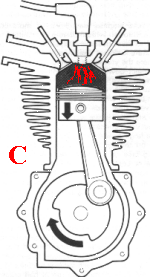
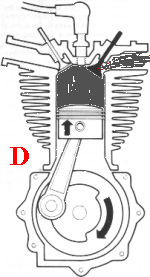
An introduction to motorcycle engines - OHV, SOHC and DOHC.
Suck - Squeeze - Bang - Blow
A... With the Piston moving Downwards, the Inlet Valve Opens and the fuel mixture is enters the Chamber. (Exhaust valve is Closed)
B... The Inlet Valve now closes, and with the Piston on its upward stroke, the mixture is compressed. (Inlet and Exhaust Valves are closed)
C... The spark from the Spark Plug ignites the compressed mixture forcing the Piston downwards. (Inlet and Exhaust Valves are closed)
D... The Exhaust valve opens, and the exhaust gases are expelled by the piston now traveling upwards. (Inlet Valves is closed)
And the whole Process starts all over again .......
Bearing in mind that nearly all machines
are OHV, the term OHV generally refers to the way the valves are operated,
which in the case of OHV engines is by Pushrods.

In the diagram, you will see that when the camshaft turns, the Cam (lobe) begins to lift the Cam follower and pushrod, thus opening the valve via the Rocker Arm.
Up to certain speeds there are no problems, but beyond that, the weight of the Valve train components are such that they are unable to respond quick enough to the Camlobe passes and begins to fall away. At this point, the valves start to "FLOAT" and damage can occur.
Another problem arises in the weight factor of all these moving parts which need to be very strong indeed to withstand the pressures they have to bear.
These limitations forced designers
to look at other alternatives in Valve operations to improve engine performance.

In a typical SOHC engine, the camshaft
has been moved up and housed at the centre of the cylinder Head between
the valves. On some early designs, the camshaft was driven by bevel gears
and a driveshaft, but in general, a relatively cheap and simple chain drive
from the crankshaft was used.

The only moving (Non Rotating parts) left were the Rockers and Valves. Not perfect but an improvement on the older Pushrod method of valve operation.
The Diagram (Right)
highlights the differences between the OHV and SOHC and how moving parts
have been eliminated.
And in case you're confused, the
"S" denotes Single Overhead Cam as only one camshaft is used - unlike the
next refinement that uses two.
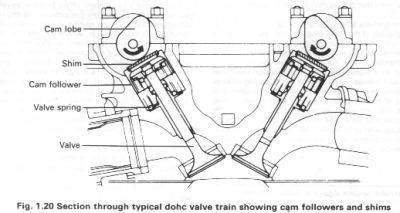
The DOHC four stroke engine was a
further refinement of the SOHC engine, designed to eliminate the only remaining
reciprocating weight, the Rockers. Instead of a Single central camshaft,
two are used positioned directly over the Valve stems.
Since there is no way an easy conventional
adjuster can be fitted, shims (thin discs of metal) are used to set the
clearance gaps between Cam Lobes and Valve Stems.
So there you have it - the Technical Jargon watered down for us all to understand. But Hang on - what's all this you've heard about the Revolutionary Four Valve Engine ? ......
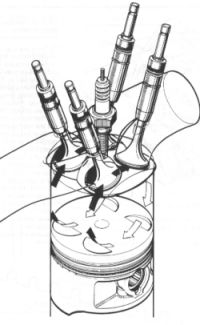
It should be noted that neither the OHC, nor indeed the Four Valvers are new innovations, both having appeared many years ago in form or another. Rather, they have been refined to the point of the modern day machine. Other refinements such as the Laydown engine (also not a new idea) have been added to the modern Speedway machine, but we hope this has helped clear up some of the Technical Jargon when referring to Engines .......